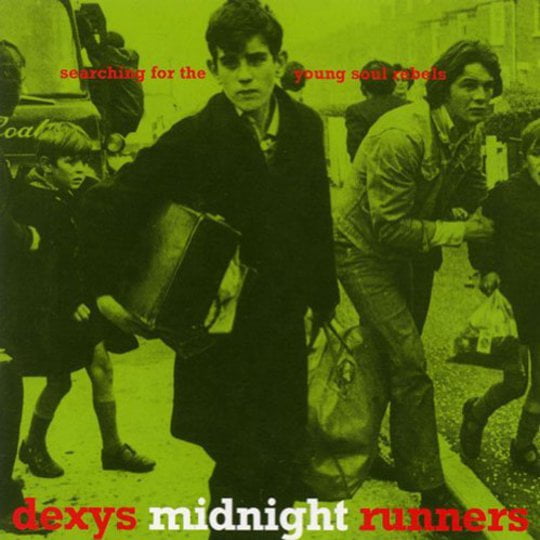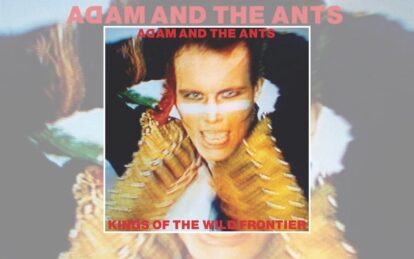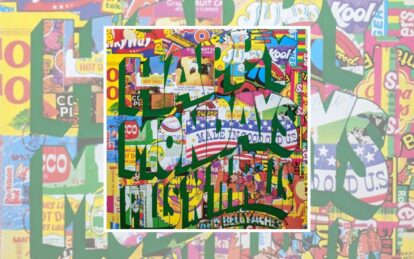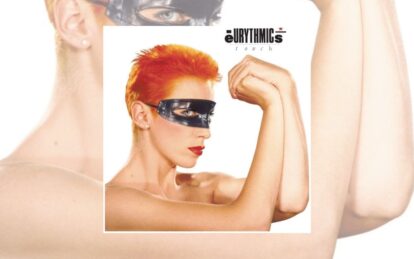
Searching For The Young Soul Rebels cover
In 1980 Dexys Midnight Runners arrived with their debut LP, Searching For The Young Soul Rebels, an album that reinvented American soul through a gritty British lens… By Gary Tipp
Punk rock exploded in the UK during the summer of 1976 leaving all, albeit temporarily, in its incendiary wake. Years later when the dust had settled on the gob-soaked scene it became apparent that rather than being the beginning of a glorious new musical chapter it was actually an emphatic full stop.
Without question, the Sex Pistols, The Clash, The Damned and others had given the ruling rock establishment a much-needed boot up the jacksie, but, ultimately, punk’s inability to go beyond rock’s clichéd three-chord fundamentals meant sonically it hadn’t done much more than churn up old ground.
The instigator of this anticipated new chapter turned out to be post-punk, the innovative movement that followed. The post-punk bands of the late 70s and early 80s were imbued with a fresh spirit of adventure to explore new avenues and create original sounds.
They dressed in a sombre fashion and were glacially serious about the music they were making. These groups voraciously gleaned high ideas from art, literature, philosophy and politics and looked towards Europe for their inspiration.
Only a couple of years or so after the initial explosion, stellar bands, mostly made up of former punks, such as PiL, Joy Division, Wire, Magazine, Gang Of Four, Siouxsie And The Banshees and Simple Minds, were now at the front of the forward-leaning, post-punk vanguard.
Despite being in a punk band together, Dexys Midnight Runners founders Kevin Rowland and Al Archer defiantly chose to ignore every single trope in the post-punk playbook and take things pretty much in the polar opposite direction. It was a swimming-against-the-tide trick that Rowland was to repeat many times during his exhilaratingly unpredictable career.
Searching For The Young Soul Rebels – Geno
The Killjoys, their group, had disbanded after one semi-memorable single, Johnny Won’t Get To Heaven on Raw Records, when Rowland had had his fill of punk’s limitations. Instead of peering over the English Channel for creative motivation, he and Archer focused their attention on the other side of the pond.
It was during this period Rowland informed Archer: “I’m going to do what I really want to do. Form a great group, we’ll wear great clothes and make soulful music.”
As the quixotic frontman further recalls: “I was totally fed up with everything else at that time and so I started listening to all of Geno Washington’s old records and any other soul singles I could pick up for 10p around the markets.”
Rowland’s incongruous ‘new soul vision’ led to the first incarnation of Dexys Midnight Runners, a Stax-style soul band complete with a powerful horn section. The Geno Washington connection dated all the way back to Rowland’s first ever live gig at the Railway Hotel in Harrow at the age of 15 (“Back in ’68 in a sweaty club”) when his older brother had taken him to see the great man perform alongside the legendary Ram Jam Band.
Read more: Adam Ant – The Complete Guide
Read more: Top 40 80s Debut Albums
The band’s name was derived from Dexedrine, a type of amphetamine used as a recreational drug among Northern Soul fans to give them energy to dance all night. This was a nugget of information that had previously passed Tiswas presenter Sally James by and led to an awkward silence on the live-on-air kids’ Saturday morning show when she innocently asked Rowland and Archer the origin of the Dexys moniker.
Adverts were placed in local papers and the tortuous process to find the right band members began. Bass player Pete Williams from Archer’s previous group, The Negatives, Hammond organ player Pete Saunders and drummer John Jay were the first to sign up, and when saxophonists Steve ‘Babyface’ Spooner and Geoff ‘JB’ Blythe (formerly of the Ram Jam Band) were joined by trombonist ’Big’ Jimmy Paterson and the curiously nickname-free trumpeter Geoff Kent the first lineup was complete.
After briefly dabbling with standard new wave attire, arch-conceptualist, control freak and fully trained hairdresser Rowland devised a stylised look for the group. Strictly no long overcoats, post-punk peg trousers and buttoned up shirts here, the first Dexys’ lineup took its sartorial cues straight from Martin Scorsese’s 1973 movie Mean Streets.
The look was later tweaked again. This time the movie inspiration was On The Waterfront and the band began dressing like New York dock workers complete with woolly hats, leather coats, donkey jackets and white socks. Naturally, it would be remiss to mention that those unaware of the pop-cultural reference often mistook the guise for that of a horde of snazzy council binmen.
Searching For The Young Soul Rebels – There, There My Dear
In the manner of a Captain Beefheart or The Fall’s Mark E Smith, messianic pack leader Rowland and comrade-in-arms Archer were keen to mould the members into a hive-minded collective. To this end, the band was subjected to marathon practice sessions. They would jump over the barriers to bunk on trains, go on shoplifting sprees and, strangest of all, set out running as a team together.
As Rowland recalls: “We used to come into the rehearsal rooms still sweating from running, and there were all these other groups there and it just put us a million miles away from them.”
Dexys fast earned a reputation as a blistering live act gigging in and around their home base of Birmingham. The intensity and passion of their live performances further set them apart from the bloodless post-punk scene.
Despite a revolving door policy when it came to band personnel, the group secured a support slot playing alongside The Specials and The Selecter. 2 Tone’s head honcho Jerry Dammers offered the band the opportunity to cut their first vinyl on his label, but the proposal was declined.
A deal was then struck with Bernie Rhodes who released the band’s first single on his EMI offshoot Oddball Productions label, the former Clash manager also taking a seat in the producer’s chair. Dance Stance unexpectedly reached the lower limits of the Top 40 and enabled the band to make its Top Of The Pops debut.
Unhappy with Rhodes’ production, the band swiftly kicked him into touch, signed on the dotted line for EMI and began the hunt for a producer for their debut album.
Searching For The Young Soul Rebels –Dance Stance
The doubtful honour fell to Pete Wingfield, who was not only a one-hit wonder (‘I’m 18 with a bullet/ Got my finger on the trigger/ I’m gonna pull it”) but was also a soul specialist, and, tellingly, had played with Van Morrison at 1974’s Montreux Jazz Festival.
The band, with yet another iteration of the lineup in place, recorded Searching For The Young Rebels over 12 days in April 1980 at Chipping Norton Recording Studios. When pushed on the meaning of the album title an intractable Rowland replied: “I don’t know. I just liked the sound of it, really.”
As they entered the studio the band’s previously recorded second single Geno was inexorably stomping its way up the UK Singles Chart, eventually reaching the No.1 spot on 27 April.
Egged on by their sudden popularity and fuelled by increasing tensions with EMI about the perceived poor terms of their recording contract, the eternally antagonistic Rowland threatened to steal the master tapes from the studio and hold them to ransom unless the band’s contract was improved. It was a threat that initially the record company failed to take seriously.
In fact, it was anything but a bluff, as on the last day of mixing the album, while Wingfield was out of the studio grabbing a coffee, each member of the band swiped a carton of magnetic tape, legged it to a waiting getaway vehicle, and sped off to stash them round Rowland’s parents’ house in Birmingham.
Incredibly, the stunt worked and EMI reluctantly acceded to a rise. On returning the masters back to the label, so the story goes, the band inadvertently risked demagnetising the tapes and wiping the entire album after transporting them through the barriers on the Underground.
Searching For The Young Soul Rebels was eventually released on 11 July 1980 and sold well, reaching No.6 in the UK Albums Chart. Reviews at the time were hugely positive, aside from the occasional barb aimed at Rowland’s idiosyncratic, strangled yelping vocals. The album featured high in the best of the year charts across the UK music press, too.
Searching For The Young Soul Rebels – I Couldn’t Help If I Tried
It was also notable for the use of an impactful cover image which features a photograph of a ruffled 13-year-old Irish Catholic boy carrying his belongings after being urgently forced from his home in Belfast due to the introduction of internment in 1971.
Rowland, who was born in Wolverhampton to Irish parents, freely admits it was an image chosen solely on aesthetic rather than political value.
Many years later, Anthony O’Shaughnessy, the young lad in question, neatly completed the circle by meeting up with the frontman in Brighton for a quick chat. It’s also rumoured that O’Shaughnessy once turned up at a Dexys gig with a large cardboard cut-out of himself.
The second single released from the album, the rollicking There, There, My Dear, also broke into the Top 10, peaking at No.7. But from here on in that was as good as it was going to get for Dexys Mark 1. Firstly, Rowland declared a press embargo, refusing to do any interviews with “the dishonest, hippy press.” Then a couple of singles (Keep It Part Two and Liars A To E) failed to make even the slightest impression on the chart.
And, so, in early 1981, sick to the back teeth of the dictatorial demands of their leader, five members of the band upped sticks to form short-lived, brassy soul outfit The Bureau. And when the long-suffering Archer also decided to call it a day, Rowland and the faithful Paterson were the last two members standing.
Now was the time for the two of them to put the donkey jackets in mothballs, donate the woolly hats to the nearest charity shop and get the denim dungarees back from the dry cleaners.
Searching For The Young Soul Rebels – The Songs
Burn It Down
Searching For The Young Soul Rebels starts with the sound of a radio being tuned in, followed by brief snatches of Deep Purple’s Smoke On The Water, Sex Pistols’ Holidays In The Sun and Rat Race by The Specials before the brass section launches headfirst into the song. Burn It Down is a faithful reprisal of the band’s first single Dance Stance. Its chorus is made up of a list of celebrated Irish writers and forms part of Rowland’s fierce reaction against anti-Irish prejudice, which was prevalent at the time (“Never heard about Oscar Wilde and Brendan Behan, Sean O’Casey, George Bernard Shaw/ Samuel Beckett, Eugene O’Neill, Edna O’Brien and Laurence Stern”). “I was saying, ‘If Irish people are so thick, how come they’ve produced all these great writers,” Kevin explained.
Tell Me When My Light Turns Green
The worldly Rowland had, indeed, seen quite a bit in his 23 years and had written the lyrics for this when still a member of The Killjoys four years previously (he was 27 when he recorded …Soul Rebels). The upbeat song’s anger and punk spirit translate effortlessly into a soul setting, which is a neat trick if you can achieve it. Incidentally, The Killjoys’ bass player was Gil ‘Gem’ Weston who later found her niche as a member of heavy rockers Girlschool.
The Teams That Meet In Caffs
Side One’s atmospheric instrumental was written by Rowland’s long-term, long-suffering collaborator Al Archer. As you can only imagine, the former Killjoys guitarist was no stranger to his bandmate’s dominant personality. Indeed, Archer’s Christian name is actually Kevin, but adopted the ‘Al’ tag on the insistence of Rowland who didn’t want to be in a band that featured two Kevins. On another occasion, the alpha-frontman forbade Archer wearing a red woolly hat instead of the standard issue blue or black.
I’m Just Looking
The B-side of debut single Dance Stance, I’m Just Looking is a down-tempo, self-flagellating slice of theatrical soul. The slow-burning, bluesy ballad is central to the album’s emotional spine. Channelling his inner
Van Morrison, Rowland’s intense vocals drip passion and self-pity in equal measure. Incidentally, within band circles major influence Morrison was always referred to as Stan Morrison.
Geno
The final track on Side One needs little introduction, and harks back to the first gig Rowland ever attended. On the surface of things, it’s a straight-up celebration of his enduring appreciation of the journeyman US soul singer Geno Washington, who helped inspire (not academically) the Dexys Midnight Runners sound. Scratch deeper and Geno is also an examination of the cyclical nature of entertainment. As Dexys hit the No.1 spot, Washington was barely eeking out a living on the cabaret circuit. The band is self-referentially name-checked when comparing the Ram Jam singer to the mod scene’s drugs of choice (“This man was my bombers, my Dexys, my high”).
Seven Days Too Long
Side Two opens at breakneck pace with a frantically faithful cover version of Chuck Wood’s 1967 Northern Soul classic Seven Days Too Long. Rowland has a high time
with the vocal, and finely treads the line between lovelorn and utterly certifiable. What this highly enjoyable appropriation loses in funk from the original it certainly makes up for in raw energy.
I Couldn’t Help It If I Tried
The album’s second downbeat ballad, I Couldn’t Help It If I Tried sees Rowland play out another overwrought psychodrama (“Cos you drank my blood/ And there’s no more left for you”). The impassioned, hyper-soulful delivery explains why the Dexys’ tour immediately following the album release was called ‘the Intense Emotion Review’.
Thankfully Not Living In Yorkshire It Doesn’t Apply
A moment of light relief amongst all the naked emotion, this cryptically titled and slightly bonkers filler is a bright and breezy affair, certainly when compared to the heavyweight downers either side of it. The song’s meaning, if there is one, is rendered utterly unfathomable by Rowland’s barely decipherable cod-falsetto vocals.
Keep It
Yet more soulful self-loathing played out publicly in song, Keep It was the track that finally split up the first incarnation of the band. Despite complaints from EMI that it was uncommercial, a reworked version called Keep It, Part 2 (Inferiority Part 1) was released as a single on 17 November 1980. It failed to make an impression on the charts and soon after the album lineup splintered with five members quitting the band.
Love Part One
This spoken word piece comfortably takes the biscuit as the most pretentious 1:12 on the album. Rowland’s tormented monologue cast over a wailing saxophone solo is as comical, in a sixth form poet way, as it is crazily ambitious (“Am I the first to ever question you exist?/ Why do I throw up when she says she gives me herself only for you/ Or her belief in you is only for me/Sometimes I almost envy the need, but
don’t see the prize”).
There, There, My Dear
Written as an open letter to a pretentious musician, this classic album closer is Rowland’s takedown of what he perceived to be a dishonest music scene (“If you’re so anti-fashion why not wear flares/ Instead of dressing down all of the same”). He told The Guardian: “It’s an angry song. In the lyrics, I’m addressing ‘Robin,’ but he was the personification of a certain type of middle-class musician, quoting Kerouac and Burroughs and all these authors I’d never read.” It’s by far one of Dexys Midnight Runners Mark 1’s most thrilling moments and the horn section has never sounded more potent. Possibly as a portent to the changes which were about to come, at the very end of the track in hushed tones Rowland sings the chorus of New Orleans R&B legend Lee Dorsey’s Everything I Do Gonh Be Funky (From Now On).
Follow Dexys on Twitter
Classic Pop may earn commission from the links on this page, but we only feature products we think you will enjoy.






